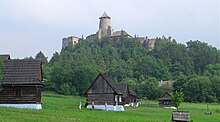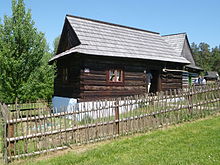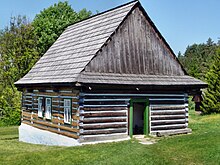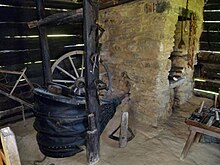Stará Ľubovňa open-air museum
The open-air museum Stará Ľubovňa ( “Ethnographic exhibition in nature - Open-air museum Stará Ľubovňa” , Slovakian Národopisná expozícia v prírode - Ľubovniansky skanzen ) is located in Stará Ľubovňa , in the Prešovský kraj in northern Slovakia . It consists of a group of buildings that present the folk architecture , way of life and culture of the northeastern Spiš and Upper Šariš , in an ethnically mixed region for centuries where Slovaks , Carpathian Germans , Russians , Gorals , Jews and Roma lived. The ethnic diversity is evident in the striking folk architecture as well as in the form of cultural experiences. A total of 25 wooden buildings date from the late 19th to early 20th centuries. The proximity of the Lublau Castle ( ubovniansky hrad in Slovak ) makes the open-air museum particularly attractive.
Definition and history
The exposition managed by the Ľubovňa Museum was opened in 1985 . The objects mostly come from the Ukrainian-Ruthenian area, plus a Goralen house with a barn from a Slovak village and a German Spiš residents house with Dufart . Most of them are former residential buildings from the villages: Veľký Lipník , Litmanová , Veľká Lesná , Údol , Jarabina , Jakubany , Kremná and Kamienka . Agricultural buildings such as sheds, barns and granaries come from the Údol, Legnava and Kremná. Seasonal homes come from Litmanová. Technical monuments are represented by wrought iron products from Torysa , a mill from Malý Sulín and a carpentry workshop from Piľhovčík .
Attractions
The wooden Greek-Catholic church of Archangel Michael from Matysová is considered the most valuable exhibit of the entire exhibition. The block construction with tower and nave dates from 1833 . In the interior there is the iconostasis, the altar of the Transfiguration and also independent icons from the mid-seventeenth century. They were painted under the influence of Byzantine art . The icon of the Archangel Michael from 1640 is the oldest. This Orthodox church object came to the museum in 1979 and was consecrated again in 1991 . During major religious holidays, the liturgy or service is celebrated here.
The two- room house from Litmanová , which represents the way of life of a Ruthenian village, was built in 1921 for the village shepherd . The main living room is a simply furnished room that the family served all summer. In the entrance area is the oldest surviving oven in the upper Zips .
The house with the so-called Dufart belonged to a Zipser German family. German settlements (mainly mining settlements in the Unterzips) date from the 12th century, most of them after the Mongol invasion in 1242. German specialists and miners from Silesia and Central Germany brought into the country by the Hungarian kings were supposed to help rebuild the country that had been destroyed by the Mongols . The building differs from the Slovak house not only externally, but also in the different construction and interior layout. This type of settlement also occurs in the vicinity of Ružbachy and Zamagurie.
The village judge's house from Veľká Lesná from 1909 has a symmetrical floor plan. The main room is in the middle of the house. The corridor was not originally heated, but after the Second World War it was converted into a kitchen by installing the economy stove . The house originally had a large entrance gate at the front from the courtyard.
The Torysa village forge - a one-compartment wooden building - dates from the second half of the 19th century. A roofed room in front of the forge was used for shoeing horses and cattle. The exhibition consists of basic equipment of a chimney with a comprehensive collection of forging die and forging products.
The mill Sulin - a wooden building with a basement and two floors - was rebuilt in the 1930s by the original stone mill to a rolling mill. There is a gear drive unit in the basement. The mill equipment (set of rollers and peeling machine for groats) is located on the ground floor; in the center of the room is a grain bin. With wooden pipes they pulled out the wheat into the top grain bin, from where it then fell to the grinding rolls. The grinding of the grain parts was carried out several times and then sieved off several times.
See also
Individual evidence
- ↑ a b Iveta Zuskinová: Open-Air Museum . In: Cultural Heritage of Slovakia . Dajama, Bratislava 2008, ISBN 978-80-89226-58-0 , p. 66 .
- ↑ Iveta Zuskinová: open-air museum . In: Cultural Heritage of Slovakia . Dajama, Bratislava 2008, ISBN 978-80-89226-58-0 , p. 66.67 .
- ↑ Iveta Zuskinová: open-air museum . In: Cultural Heritage of Slovakia . Dajama, Bratislava 2008, ISBN 978-80-89226-58-0 , p. 68 .
- ↑ a b c Iveta Zuskinová: Open-Air Museum . In: Cultural Heritage of Slovakia . Dajama, Bratislava 2008, ISBN 978-80-89226-58-0 , p. 70 .
- ↑ Iveta Zuskinová: open-air museum . In: Cultural Heritage of Slovakia . Dajama, Bratislava 2008, ISBN 978-80-89226-58-0 , p. 71 .
Web links
- www.muzeumsl.sk (Slovak) (English)
- Description of the open-air museum on www.muzeumsl.sk (English)
Coordinates: 49 ° 19 ′ 2 " N , 20 ° 41 ′ 43" E








